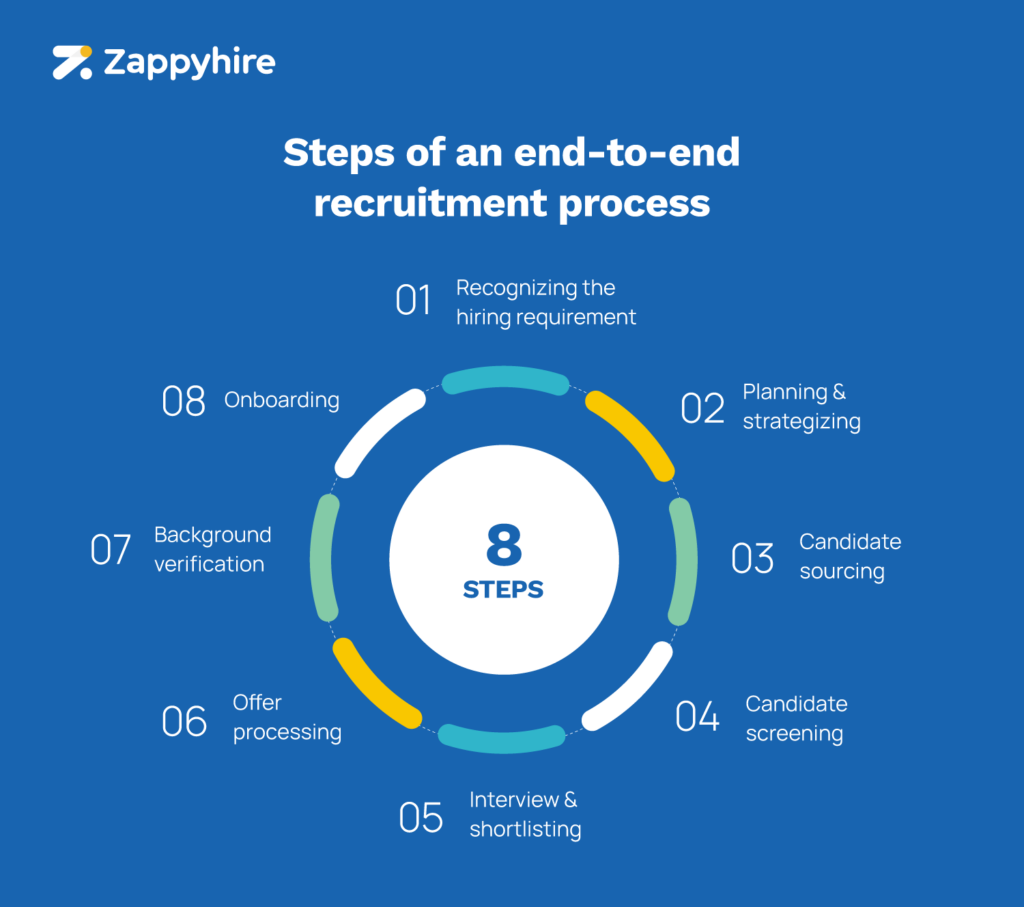
Do you ever find yourself wondering why recruiting for a single role has to be such a long-drawn process with multiple complicated stages?
Well, recruiting isn’t as simple as picking candidates at random! Finding the right fit for a role demands a series of essential steps and careful strategizing.
This is because without an end-to-end recruitment process, hiring can become inconsistent and disjointed.
This inconsistency can negatively impact the overall candidate experience, quality of hires, hiring costs, and much more.
Therefore, it’s crucial for hiring teams to implement the right recruitment steps in the right sequence to ensure a seamless and successful hiring process.
8 key steps of an end-to-end recruitment process

An end-to-end recruitment process, or full-cycle hiring, refers to a comprehensive series of steps that covers the entire hiring journey.
It begins with aptly identifying the need for the role and ends with the onboarding of the successful hire!
Recognizing the hiring requirement
The very first step in an end to end talent acquisition process is to accurately identify the need for a new hire.
The reason to hire can vary – it might be to replace an employee who left, scale up as the organization grows, or address specific demands of an ongoing/upcoming project.
Hiring teams need to assess the workforce, evaluate employee performance, identify skills gaps, and determine what kind of hire is needed accordingly.
This could mean creating a new role based on:
- Project requirements
- Addressing team workload
- Building a new team as the company grows
- Upskilling certain roles to meet new demands
Following this identification, managers or HR professionals put in a formal request to hire for a particular role, known as job requisition.
This step is integral as it sets the basis for the rest of the hiring process to follow.
Planning & strategizing
Once the hiring requirement is crystal clear, it’s time for action!
However, it’s imperative to bear in mind that each organization has its own unique recruitment challenges and limitations.
To cope with these challenges that could range from limited recruiters, budget constraints, tight deadlines, etc., strategy is key.
The hiring team must clearly define what they’re looking for – be it skills, qualifications, personality traits, experience – all specified to the T.
Therefore, it is important that the requirements are specified clearly in the job description to attract the right candidates.

It’s crucial that the job description is appealing, concise, unambiguous, and impactful.
This is the first indirect touchpoint with candidates, so getting it right makes a great first impression!
HR teams must also make sure to determine the budget to be allocated, the estimated hiring timelines, etc.
In this way, the next steps of the process can be accordingly planned, ensuring a hiccup-free end to end hiring process.
Sourcing the candidate
Next, we have an important stage in the end-to-end hiring process: candidate sourcing.
This is the candidate pool you’ll work with throughout the process, so getting it right, right from the start is essential.
It is the quality of this talent pool that impacts the quality of hires you make at the end of the day.
However, sourcing the right candidates is a major recruitment challenge (76% of hiring managers report the same).
Therefore, recruiters need to appropriately identify the right channels for sourcing candidates.
This includes tapping into job boards, career sites, referral programs (which account for 40% of successful hires), and social recruiting, among others.

Implementing passive recruitment strategies (targeting candidates who aren’t actively job-hunting but have the desired skills) can also be very effective.
This is because passive candidates make up a significant chunk (70%) of the workforce and are often highly skilled and experienced.
Screening and pre-screening of candidate
After the candidate sourcing phase, the candidate screening stage helps weed out unqualified candidates who likely won’t be the right fit for the role.
The candidate screening process includes two main stages: candidate pre-screening and candidate screening.
- Candidate pre-screening: This initial phase includes steps like phone screenings, resume parsing, pre-screening interviews, preliminary skills assessments, etc.
Here, the aim is to quickly sift through applicants to find those who meet the basic requirements. - Candidate screening: This involves more in-depth evaluations, such as interviews and technical assessments, to assess each candidate’s suitability for the role in more detail.
Additionally, it might be beneficial to consider using automated video interviewing, which can be a huge asset as they simplify the screening process.
It would not only expedite the entire process but also reduce a significant amount of manual workload, allowing recruiters to focus on other high priority tasks.
Interview & shortlisting the candidates
The interview stage, where the hiring team engages directly with shortlisted candidates, offers the perfect opportunity to gain insights into each candidate’s-
- Skills,
- Personality,
- Communication skills,
- Language proficiency,
- And overall fit for the role.
However, one-third of candidates report that a slow/poorly managed interview process makes them feel undervalued and impacts how they view the organization.
Therefore, it’s essential that organizations strive to provide structured interviews and a fair interview process to improve the experience.
This is where the right recruitment automation tool comes in handy!
This would help to – expedite processes, improve candidate experience, achieve unbiased and accurate evaluations, reduce scheduling conflicts, enhance scalability for high-volume hiring, etc.
A seamless interview funnel and positive interview experience can help boost the candidate’s interest in joining the company.
Processing the offer to the candidate
You and your team have finally shortlisted and finalized the perfect candidate for the vacancy. Great! Now begins the negotiation phase.
Once the candidate is aware of their selection, the organization should clearly communicate the salary package, employee perks and benefits, holiday policies, paid time off, and other key details.
After discussing these terms and reaching an agreement, a formal offer letter is drafted and issued.
The letter should outline all terms and conditions that have been agreed upon as clearly as possible.
It’s of great importance for the organization to present an appealing offer promptly, ensuring competitors don’t get to them first.
Be flexible and willing to accommodate the candidate’s reasonable requests as it can also strengthen their commitment towards your organization’s offer.
Post this, the offer letter is sent, and the candidate is expected to accept or decline within a stipulated time frame.
Therefore, an organized and transparent offer process helps close the hire successfully.
Background verification of candidates
Once the candidate has accepted the offer, the organization must ensure that the new hire is trustworthy.
They must also proactively make sure that all the provided information is verifiable and accurate.
The background verification process involves several checks, such as:
- Identity verification
- Criminal record checks
- Educational qualification verification
- Address verification
- Reference checks, among others
For companies hiring at scale especially, investing in background verification (BGV) tools or recruitment automation tools that integrate with BGV vendors can be of great value!
These tools help streamline and automate the numerous verification processes, reduce repetitive manual work, minimize errors, and speeds up the process.
Onboarding the new joinees
Towards the end of an end-to-end talent acquisition process comes the onboarding stage.
This step focuses on seamlessly integrating the new hire into the company, its operations, and its culture.
Just because an individual has accepted an offer doesn’t mean they’re guaranteed to stay long-term.
Any missteps or dissatisfaction during onboarding (which is the first actual experience they’ll have of working within the organization) can lead to early attrition.
It’s essential that the HR team makes every effort to help the new hire feel welcomed, comfortable, and at ease.
During this phase, new employees typically participate in training sessions, briefings on tasks and ongoing projects, gain insights into the work culture, interact with colleagues, and complete necessary paperwork.
A well-structured onboarding process ensures smooth execution and employee satisfaction!
Additionally, implementing a buddy system can also be extremely effective in helping the new employee settle in well and reducing any initial nerves.
Note: Buddy system refers to the onboarding practice of assigning an experienced employee or “buddy” to a new employee to support them during their initial days.
Ultimately, successful onboarding is all about being clear, receptive, patient, flexible, and organized.
To reiterate…

It is essential that hiring teams understand the importance of being aware of the critical steps that constitute the recruitment cycle from beginning to end.
Having a solid full-cycle recruitment strategy can do wonders in reducing time-to-hire, enhancing candidate experience, improving the quality of hires, decreasing workload, etc.
This is owing to the fact that the organization’s recruitment operations become more streamlined, efficient, and much easier to manage.
Now, imagine having a platform that could automate your end-to-end recruitment process, how great would that be?
Care to check out Zappyhire, the #1 end-to-end recruitment solution designed for medium and large companies?
Book a demo now!





